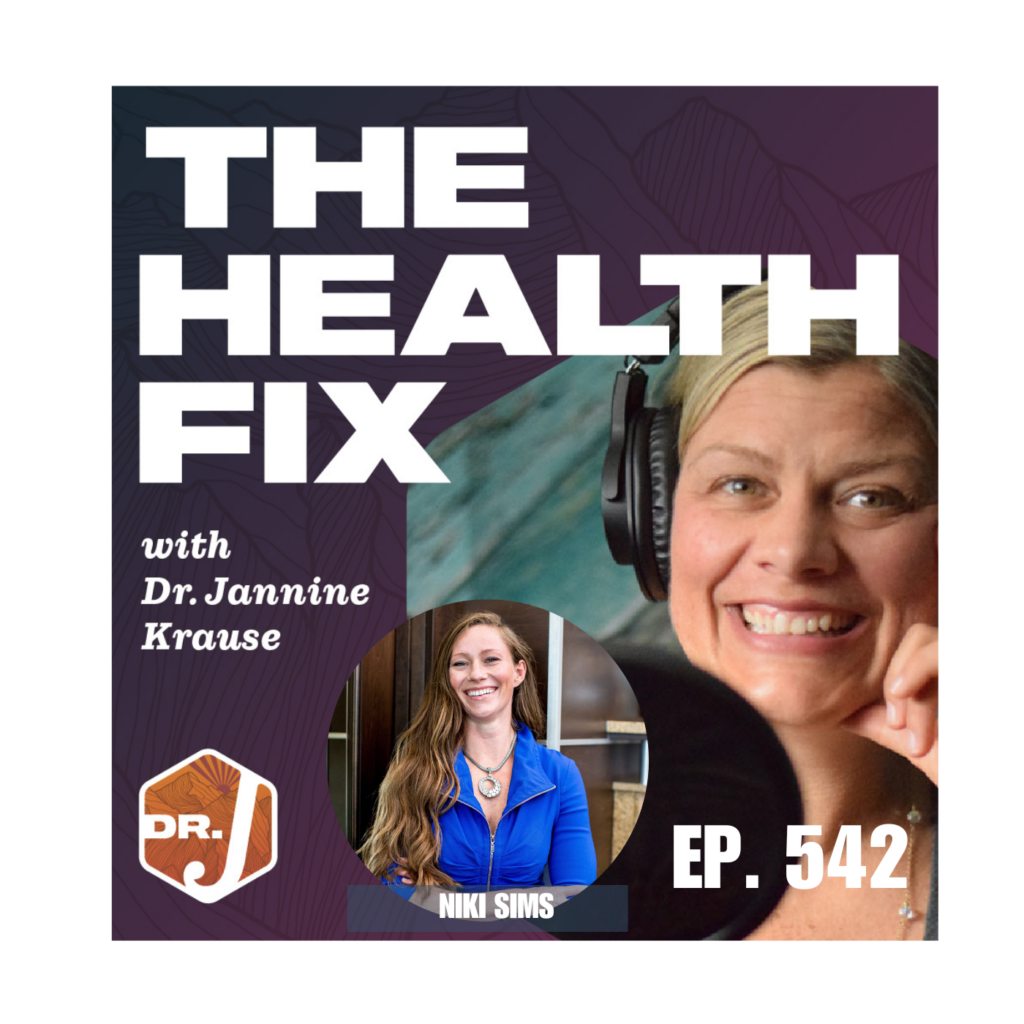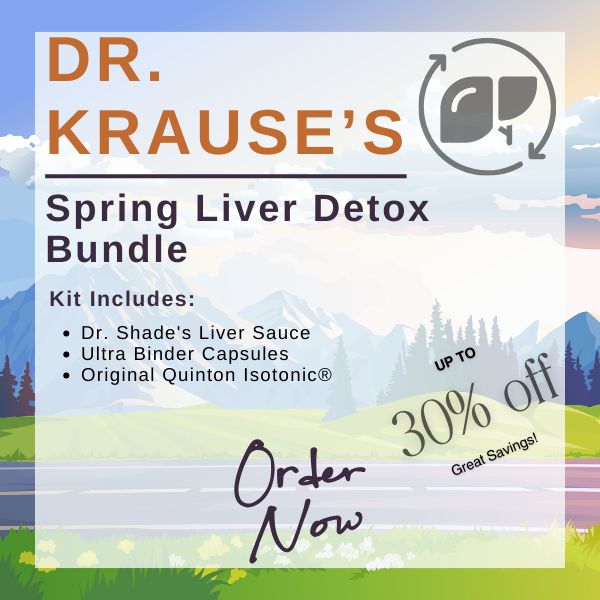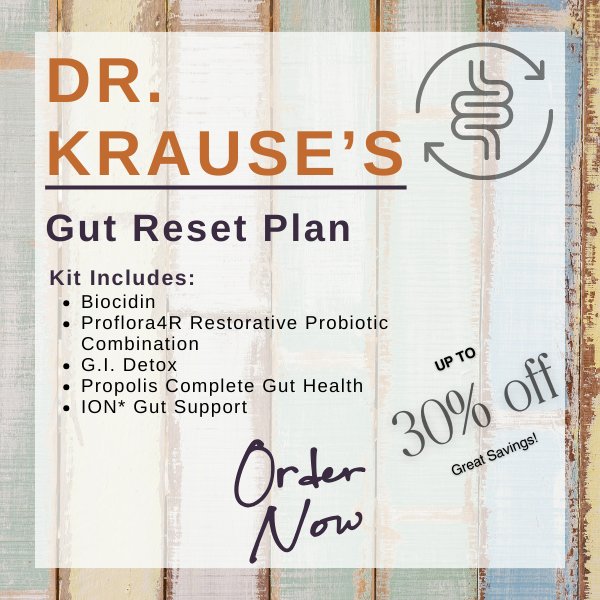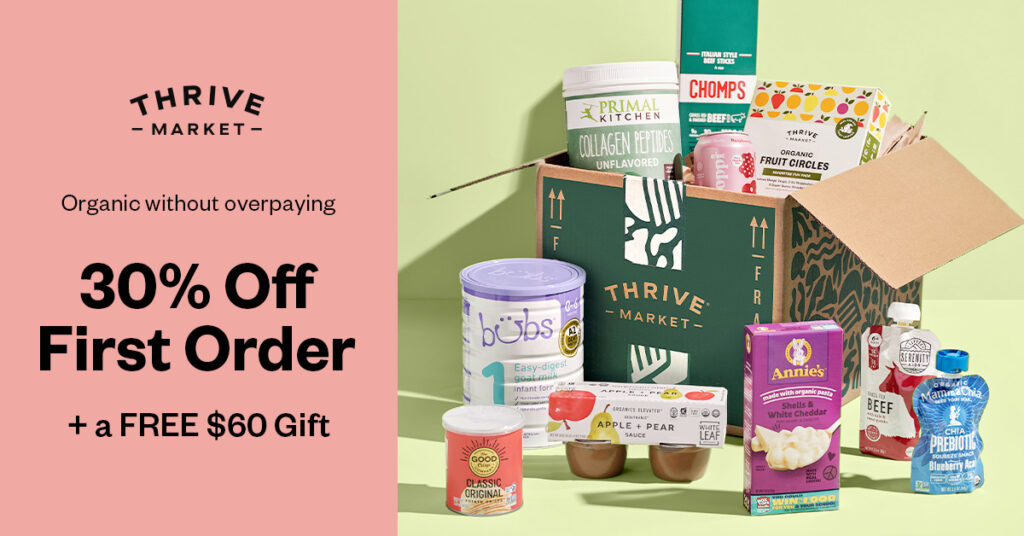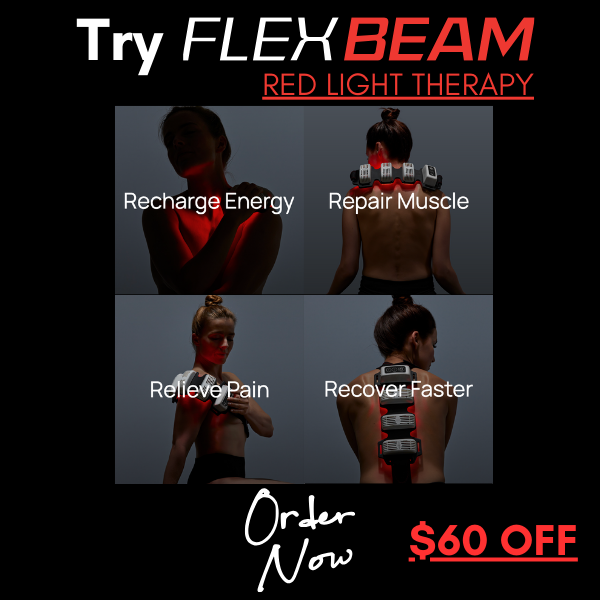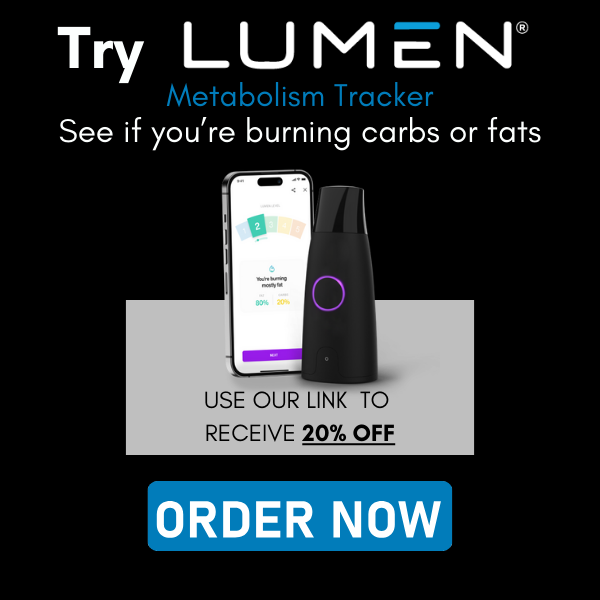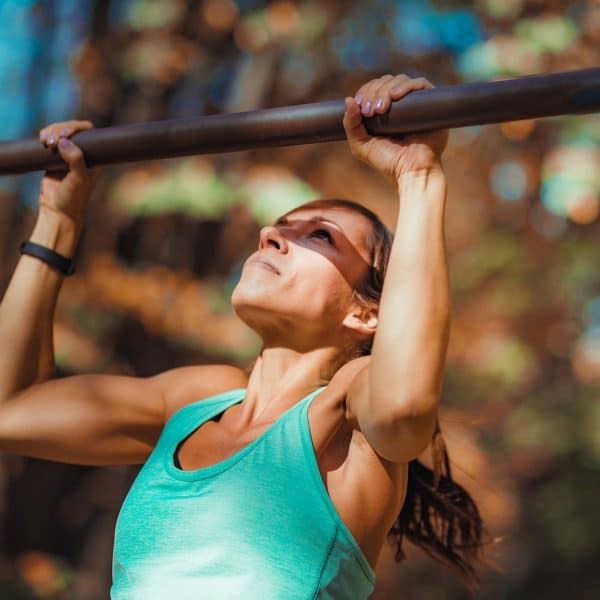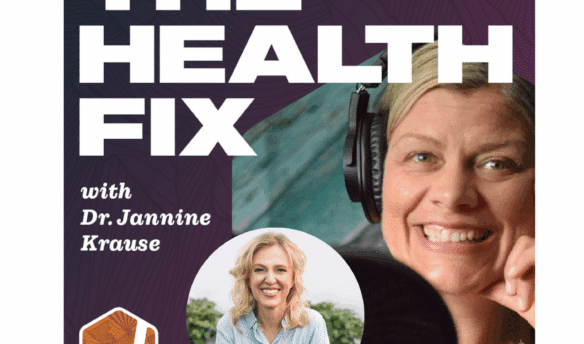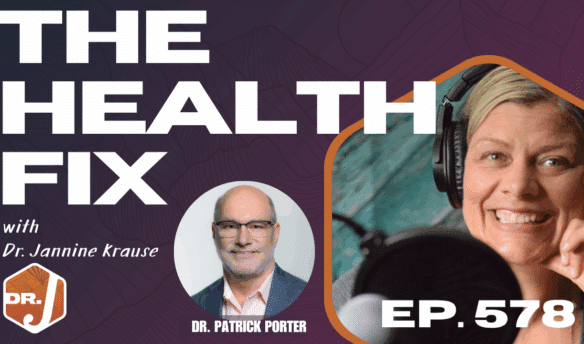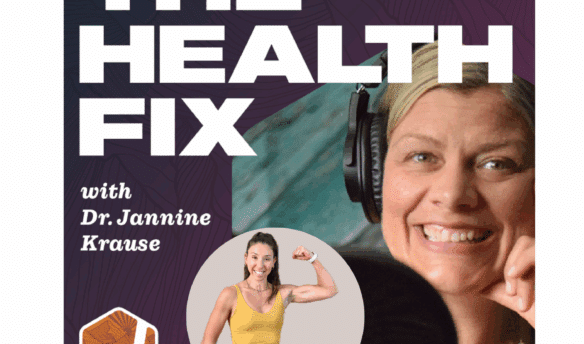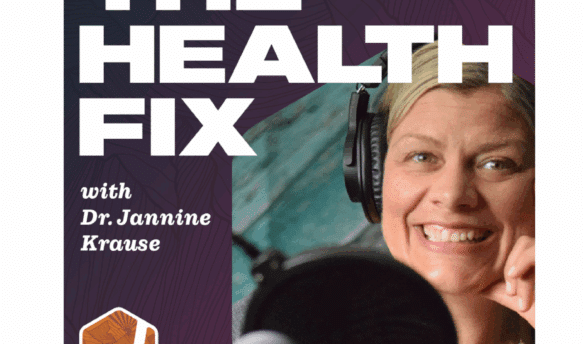In this episode of The Health Fix Podcast, Dr. Jannine Krause sits down with Niki Sims to explore why strength training is like a health 401(k)—an investment in your future well-being! With over a decade of experience in barbell coaching, Niki specializes in creating personalized training programs, refining technique, and fostering a supportive environment for women navigating menopause and beyond.
Dr. Krause’s Protocols
Instructions Included
Traveling soon? Looking to detox or reset your gut? Try one of Dr. Krause’s Fullscript plans.
What You’ll Learn in This Episode:
✅ Why lifting heavy (but do-able) weights is key to building progressive strength
✅ How your strength can significantly increase in just 4 weeks
✅ Why you’re stronger than you think—and how to prove it to yourself
✅ How to incorporate sprint workouts safely to boost your cardiovascular health
✅ The truth about long-term intense cardio and weight loss
✅ The power of finding the body you feel your best in
💡 About Niki Sims:
A seasoned barbell coach, powerlifter, and BJJ practitioner, Niki understands firsthand how building muscle leads to longevity and confidence. She’s the host of the Beast Over Burden Podcast and has coached high-profile clients, including Brett McKay (Art of Manliness), Thomas Frank (YouTube Influencer), and Jordan Gross (3x NFL Pro Bowler). She also leads Barbell Logic’s Staff and Client Experience Team, helping thousands of people lift and live better.
🔗 Resources from the Show:
🎙 Niki’s Podcast – Beast Over Burden
💪 Barbell Logic Training – barbell-logic.com
🔥 1/2 Off 1st Month’s Training: Healthfix Offer – barbell-logic.com/healthfix/
📖 Read the Book – Starting Strength
Our Partners
Podcast Transcript
1:18 – Intro
3:33 – Niki’s back story
7:52 – Your health is like an investment, 401k
12:20 – Life Fit
15:14 – “Hard but doable”
25:47 – Going “full effort” high intensity
31:26 – Prowlers
34:23 – Health transformation stories
40:55 – Growth mindset
47:31 – How to find Niki online
[Preview] The type of, you know, outside the gym cardiovascular activity that seems to work really well is really high intensity sprinting.
And what I mean by this, and I’m sure you can attest to this type of conditioning, you go all out, you give literally everything that you possibly can give, you ring yourself like a towel.
Airbike, prowler are wonderful, spinbikes really good. If you have good enough form, then the
erg is great. And you only need to do like two, three, four rounds of this. It really doesn’t
have to be very much. Go into this, you know, energized, meaning you’re not hungry, you’re not
depleting yourself. The goal is to go full effort. Fuel yourself with some carbohydrates.
Fuel yourself with a little bit of protein to make your muscles feel safe so that you can actually
show up and like give it when you’re doing this.
Don’t go on there thinking like you need
to burn 500 calories ’cause you’re just gonna make that up
somewhere else more likely.
Eight nice barbell gyms now that don’t have like
Metallica on and chalk everywhere
and guys run around slapping each other.
(laughs)
[Intro] Welcome to The Health Fix Podcast where health junkies
get their weekly fix of tips, tools, and techniques
to have limitless energy, sharp minds,
and fit physiques for life.
JANNINE: Hey, health junkies on this episode of The Health Fix Podcast.
I’m geeking out with Niki Sims and we’re talking about fitness and in particular fitness
over 40.
So we’re talking about weightlifting.
We’re talking about this trend where everyone’s talking about weights, but no one’s describing
what moves the needle.
Now, Niki is one of the co-founders of Barbell Logic,
and that’s Barbell-style of weightlifting.
Now you may be thinking to yourself,
whoa, Barbell, that’s tough.
Nikki breaks it all down as to how using a Barbell
can actually help you with functional movements
as you get older, and help you to have strength
for lifting up suitcases up and overhead compartments,
squatting, things of that nature.
We talk about body images, like we get older,
we talk about some fun stories in terms of really
what cardio should be as we get older
versus a punishment and just how you can change
your thought process on fitness as you get older.
And so Niki’s all about teaching folks about how
strength training can be your health 401k for your future
and really she embodies it in this podcast
we have a great time chatting.
So if you’re interested in fitness,
you wanna learn a thing or two about what really works,
Nikki knows what’s up.
All right, let’s introduce you to Nikki Sims.
– Nikki Sims, welcome to the Health Fix podcast.
NIKI: Hey, nice to be here, Dr. J.
JANNINE: You know, we’ve been having such a fun conversation
seeing that I’m into coma right now
and she is up in Bellingham.
So we’ve been like sharing vibes up the coast here.
NIKI: It’s much Pacific Northwesterning.
JANNINE: Yes, yes, you know, it’s a good vibe.
It’s a good vibe and a good place.
And so, you know, always like to set off the vibe
of the podcast and like, hey, how did you get into
weightlifting?
How did you get into advocating for women’s health?
Like what brought you to this industry?
And then feel free to tell us a little bit about
how you got to Bellingham from California.
NIKI: Okay. (laughs)
Well, probably a similar journey as most kind of fitness
professionals end up doing where I loved working out.
And a short story, I was able to turn my passion
into a career, which I feel very lucky to be able to do.
But it started out, you know, I tried to play sports.
That wasn’t for me, not very good running on the court,
being on the team, just that people are great at that
wasn’t for me.
So I ended up at the gym, just loved going to the gym.
I would go to Jazzercise with my mom.
I would do step, I would do all the ab classes,
but just like really couldn’t wait to get to the gym every day,
which is still how I am right now.
I don’t know if that’s the case for you,
but I just look forward to it every time I get to train.
But it was always just, you know,
something that I did for fun.
And so I went to school for construction management,
got my degree in that industry.
And I worked there for, I think it was three or four years,
but then I got the CrossFit bite
and totally drank all the Kool-Aid.
I was like, you know what’ll be a good idea for me
is to take a weekend seminar, quit my successful job
and open a gym.
And so over the course of a couple years,
that’s what I ended up doing.
So I opened up a CrossFit gym in New Mexico
where I lived at the time.
And it was fun.
It was a great community,
which is what CrossFit really does for so many.
I love the community aspect of it.
But that’s where I first really got,
you know, I got acquainted with the barbell.
It became my best friend.
And as I see many times in CrossFit,
there are certain pathways where it’s like,
all right, you’re really good at this.
Why don’t you be a professional CrossFitter
and keep running a gym?
Or you get hurt and you stop.
That was another one.
Or you become really interested in the strength component.
So you go into powerlifting, Olympic weightlifting,
strongmen, and I really got into powerlifting.
And then my career switched from a CrossFit coach
to being a barbell coach.
And so I moved to San Francisco, worked in a private gym there,
moved to Atlanta, also worked in a private gym.
And then we started Barbell Logic Online Coaching.
We, the founder of Matt Reynolds in 2016.
And that’s when I thought online coaching
was going to be ridiculous.
But we’ve been able to make it work.
And we’ve been learning how to run clients
for many years of their life now,
which has been really cool to see what it takes
to work with a client for that amount of time.
Because different, it changes.
And it’s been really neat to get to interact with people
so frequently in their training,
which was really hard to do as an in-person coach,
but online we get to see them so often.
So started off as Jim Rat turned construction manager,
turned cross-switter to now,
I do client experience in online coaching.
(laughs)
It’s a fun journey.
– It is a fun journey.
It is a fun journey.
I mean, I definitely can totally see the trajectory
for myself.
gym rat, yep, got in a crossfit.
Yep, I was one of the ones that kept getting hurt,
but I decided, okay, slow it down,
go back to Barbell, do some stuff that way.
And so, yeah, it’s a trajectory, right?
And we know that this isn’t something that everyone feels.
So it’s so much of a joy, and I’m sure you can agree
that when you get someone kind of sucked in and hooked,
and then now they’re the community that is around us,
is what I was telling you actually before,
I have been seeing people for about over 10 years
here in Washington.
And half of them are from my old gym over a decade.
NIKI: Oh, that’s me.
– Yeah.
– Yeah.
– Well, there’s something about being in that workout space
together, you’re pretty vulnerable
and you’re also pretty present.
And when those two things are combined,
you have no choice but to form some sort of bond.
You get to see each other, you know, really struggle,
you know, fail and then really succeed.
And I don’t think that happens in such like a nurturing way
in many places.
So I can totally respect how your patients would want
to be with you for so long.
That’s cool.
JANNINE: It’s fun.
It is fun.
Now, you know, one of the things I was kind of saying
is you know the gym’s not for everyone.
And as we get over, like everyone’s touting,
you’ve got to do the weights,
you’ve got to get a little bit of strain training in.
You know, we’re talking about get the protein in.
But really, you know, you have a statement
that you had sent over to me about why strain training is like a health 401k for your future.
And I really do think that this is something that is incredibly powerful because so many
women will come into my practice that haven’t been in a gym and their muscle is not built
up.
Yes, it takes a little work to get there.
But at the same time, the difference between folks who are stronger versus folks who are
not in terms of having muscle, it help wise it’s a big difference.
So give us a little background on your statement, what you’ve seen, kind of why you’re like,
“This is a good investment for women.”
Yeah, I think it’s important to think of it like a slow-steady investment, 401(k) because
it’s something that doesn’t feel important in your 20s and yet that’s the best time
to get started, same thing in your 30s and really it’s true, get started whenever you
can. But it pays off when you really need it the most, which is when we don’t produce
as much estrogen, which is when we could be at higher risk for falls. We need to have
a muscled body and we need to have strong bones. And that really matters as we start
to age because if we don’t go into 40s, 50s, 60s, 70s with strong bones and with muscle
our skeletons were at risk for losing our independence but also at risk for becoming
sicker, cardiovascular disease, and even a fall at the later stage in life can actually
be a death sentence.
So if you lose your ability to not even just enjoy life but to just live on your own and
move, you’re missing out on some really potentially wonderful years, the years in our 50s and
60s when we’re hopefully retiring.
Like finally, I actually have time and then crap.
I can’t move without hurting.
You know, so it really is a slow study investment.
You can’t put your whole paycheck into it all the time.
And that goes like training.
You can’t work at full capacity all the time because you get burnt out and you get
hurt and you’ve been lifting for so long.
You know that it’s something that you have to be able to do well and do
something that’s a challenge, but you have to be able to recover from it.
And that means like you just go, you keep going.
Sometimes you don’t want to do it.
Sometimes it’s great, but you just keep doing it.
And, you know, then we get to really reap the benefits of it when we’re, you
know, at a later point in life, which is, you know, not even that old.
It’s like, it’s, it’s important in your 40s, which is young.
JANNINE: Well, you know, the, the older I get, the younger folks older than me get,
that’s, that’s what I’ve decided.
But one of the things that I’ve noticed,
I don’t know if you’ve noticed this about adventure
and retirement and travel and whatnot.
Maybe people haven’t mentioned this.
My biggest thing, I’ve traveled to a lot
of third world countries and a lot of the toilets
are pit toilets just like holes in the ground.
I’m like, I need to be able to squat really good
because that this kind of situation,
some of the rural places that I would go to in Turkey,
in particular, I was horrified, right?
but then I’m like, okay, get over it.
NIKI: Yes.
- But yeah, I said to my–
- NIKI: Such a good example,
JANNINE: One of the big reasons, and I’m guessing
you might have some folks that are like,
yeah, public bathrooms, I need that squat factor.
(laughing)
NIKI: Getting on and off of airplanes,
and even, you know, you’re gonna be riding a bus,
like, what are you gonna do with your luggage?
How are you gonna get to your flight
without needing to be there three hours in advance?
Like, little things that before you know it,
you just get to enjoy fewer and fewer things
if you’re limited by your strength and mobility.
JANNINE: Yes, I mean, just lifting, you know how many times
I see a woman ask on an airplane,
can you help me lift my bag
into overhead compartment?
I’m like, yeah.
NIKI: Yep.
(laughs)
Yes.
(laughs)
I know, I feel the same,
where I’m just like, I can help you.
(laughs)
JANNINE: I can help you a lot, lady, you have no idea.
(laughs)
NIKI: Yes.
(laughs)
JANNINE: Do people even give cards anymore, like, here’s my card.
Um, so, so let’s talk a little, let’s talk a little bit about like life
fit, because I think a lot of people hear barbell, they hear
crossfit, they hear powerlifting and they’re like, I don’t want to do
that. You know, I want to go out over public toilets and I want to be
able to lift my luggage up. So, so give us a little scoop on like
life fit and kind of how folks in that department.
NIKI: Yeah, being strong for life is like we’ve been talking about,
it’s putting on muscle and power lifters and bodybuilders, they do put on muscle.
And it’s a very outward expression of that training that they do.
But when you’re just training to, you know, make body composition changes
or to feel really good in your own skin,
you end up doing pretty similar movements
because squat, bench press, deadlift press, clean,
those are things that your body really responds to well
because we can progressively overload them,
meaning you start today with a 33 pound bar
and then you do a squat there, you develop your form,
you get to depth, and then the next time you come in,
you go a little bit heavier.
It might even only be two and a half pounds heavier,
But we’re able to really meet you where you’re at with your ability to get full range of motion,
which is usually limited by strength.
And we’re able to just kind of invite your body to get stronger and stronger at a really,
at the rate that works for you.
And so those movements are great for powerlifting because they’re huge demonstrations of strength,
but they’re great for someone who just needs to build muscle because we can go at the rate
that really is right for everybody.
And that really varies based on genetics.
It’s based on age.
It’s based on how stressful your life is.
So it’s something that you can do in the gym.
You can go to a good gym.
There are so many nice barbell gyms now
that don’t have like Metallica on and chalk everywhere.
And guys run around slapping each other.
Those are fun, but it’s not all of them now.
Like they’re really beautiful gyms now that,
and they’re actually a ton here in Washington
where they’re beautifully arranged,
the lighting is lovely,
they’re just really organized spaces
and they have really good equipment and good coaches.
Or you can do it from your house,
like setting up a marble gym in your house
is so accessible now.
And then you can make that space a really lovely space to be in.
I really love to see how people build out their home gyms
and what they keep in there and how they organize it.
And it’s a really fun way to express yourself.
So, you know, barbell training, it teaches you how to work hard at whatever level you’re at.
You don’t have to lift 200 pounds to equal strength, like maybe 75 pounds as your strength right now.
And that’s fantastic. It’s so much better than nothing.
JANNINE: Yeah.
I absolutely agree. Absolutely agree.
Now, one of the questions I get a lot from folks about increasing strength and how much weight should I always get the how much weight should I be like?
which I’m be lifting.
And is it okay if I just get to a point
where I max out at like say 75 pounds
and that’s that I just stay at that.
Can you do that?
You know, is what I get from a lot of folks.
I have to hear your thought on like lifting more and more
ways or is there a point at which some people will just
top out and that’s where it is.
NIKI: Yeah.
There’s a phrase that comes up,
we didn’t write this in our like mission statement
anything, but over the time of coaching people, this phrase came up over and over again in
many different ways.
And people will say, that was hard, but doable.
And that is basically the foundation of a good program is it’s hard, but you did it,
meaning your form is good, and you’re able to recover from it.
And if you stay at the same weight, it’s not going to be hard enough anymore to drive
progress.
you can add reps, you know, you might do five reps and six reps and seven reps and eight reps,
but you’re still going to get to a point where that’s not hard enough. And so you have to make
sure that the doable component is there and the hard component is there. And if you’re tipping one
scale too heavy, there’s no progress and you’re going to be maintaining probably something,
you know, I’ll say mediocre, but something that is not your full capacity. So I always go for
hard, but doable. That’s kind of a good frame of reference.
JANNINE: I like that. I like that.
Yeah, because unfortunately what we see if, you know,
folks are going to say a big box, Jim, where there may be like a group
class or maybe like a YMCA kind of thing, we’ll have a lot of folks that
grab their like five pound dumbbells or two pound dumbbells and they just do
the motions with this and then then they’ll come in and they’ll have,
they, why am I not gaining any strength? And so I would love for you to kind
of like even further expand on the idea of hard but doable when it comes to doing
yeah, like that versus doing something where with the barbells.
NIKI: Yeah, and the class situation is a really good one because the instructors and the gym itself
is going to be limited by how much time they can spend with each person, the equipment that they
they have available and the need to keep the class entertaining.
And a good program is more individualized.
It looks simple on paper, but it’s actually more individualized.
It’s written for the person based on what they have available to them,
time-wise, mobility-wise, equipment-wise.
And you can go out weights that are actually challenging for the person.
And it doesn’t need to be entertaining.
It needs to work.
So those classes have limitations that are not driven by the lifter,
they’re driven by the class itself.
And so when you go into something that’s actually built for you,
you have to do weights that are challenging.
And you, you are so much stronger than you think you are right now.
You have to go through this period of time where you start lifting and it’s
uncomfortable, you put a bar on your back and you squat.
And it usually doesn’t feel great or doing a deadlift.
usually doesn’t feel great. Lifting up overhead, overhead press is the ultimate ego killer.
You lift up 22 to 45 pounds over your head on the first day of pressing. You’re just like,
this is ridiculous. Why is this so hard? So you have to do these things that feel uncomfortable.
But then it’s usually like four weeks in, you really start to notice like, man, I’m doing this
so much better than I was four weeks ago. This is fun to see more weight get on the bar.
And you learn that you can get stronger and get better.
And if you don’t challenge yourself by making the wake go up in the very beginning of lifting,
you never know how capable you are.
It gets more complicated as you progress in lifting.
You know, you’ve been lifting for such a long time.
You can’t just always keep adding five pounds to the bar,
but you still have to find the hard part.
And if you go to a class, you’re not going to be able to find that because that’s not what they’re for.
JANNINE: Mm-hmm.
NIKI: It’s maybe challenging and you may get sweaty and sore, but that’s not what drives change in
your body and your muscles don’t really care about that in a way that they’re going to respond by
adding more. It’s like one analogy is, well, there’s that Milo in the bowl. Milo, he started
right now in the bowl, but he was like a young boy. He was like, I want to carry my cow up a hill.
The cow was growing every week. It got heavier and heavier and he just kept carrying that thing
up the hill. And so as they both grew, they got, Bull got heavier,
a mile ago got stronger because he kept being able to do more and
more weight and it called upon his body to get stronger.
Yeah.
Strength parable.
JANNINE: I love it. I love it.
I think.
NIKI: Yeah. What do you, what do you find works well in that?
I’m curious what you find works well when you encourage people to get
out of classes and start moving some weight.
JANNINE: You know, first and foremost, you know, it’s like,
get out and move your body weight.
That’s usually what I’ll get people out of the classes
and feel what a squat feels like.
Because as you know, probably as well as I do,
form is something very interesting sometimes.
And so I’m guessing in a lot of your classes,
you were making sure everybody’s got their form down
before they start loading with a barbell.
And so first and foremost,
I usually will start people out just moving.
Let me see your squat.
Let me see a deadlift.
Let me see how you press overhead.
Sometimes we’ll get one arm.
It’s mobility is so such a thing.
So from there, yes, then I will do the same thing,
kind of then put the barbell on,
then we put a two and a half on,
then we just kind of gently go up from there.
I think for a lot of people,
we do get in our heads about how much
you know what the amount is on the barbell.
And oftentimes when I was going for PRs,
I would not have, I was like,
don’t tell me what’s on the barbell.
NIKI: Yes.
JANNINE: Because as soon as I know,
then I’m like, I can’t lift that much.
So I’m curious to be seeing that with folks
when you go to like trying to load things on the bar.
NIKI: I had a really interesting moment last year.
We did a little special on the Montel Williams Show
and we like really quickly had to teach them how to lift.
So his co-host Olga, we set her up with a light bars,
like 10 pounds.
And then we put bumper 10s on either side.
And so this is 42 pounds,
but she wasn’t able to pick it up at first.
And she totally could, she’s very athletic.
But it looked so huge, those bumper 10-pound plates,
they look like what most people believe is 45 pounds.
And she was able to get it, you know, very quickly.
But it was really interesting
that looked like too much when in fact she’s very strong,
could totally pick that up.
So you’re exactly right.
Like it might be making them hold the two and a half pound
plate and being like, this is all I’m adding to your bar.
See how light it is?
Like you can do this or not using the bumper 10 pound plates
or using the 22 pound bar and be like,
this is how light it is on its own.
But yeah, you do have to– there is this period of time
where you kind of have to trick–
do some trickery in like a way of making it,
making us understand how capable you are,
not just trying to like con someone into doing something,
but to just like let your brain associate
with like, this is okay.
JANNINE: Right.
Oh my gosh, I think that conning thing,
I think we do have to talk about that
’cause a lot of people have been hurt,
you know, by lifting more than they handle.
And definitely guys, I’m not talking about
for sure, anybody to lift anything more than they could handle,
but for a lot of people, you know,
coaches that have been doing it for a while know,
like we can tell when you got more in the tank there.
NIKI: Yes.
(laughing)
– Yes.
JANNINE: Interesting, Montel Williams.
How was that to be on that show?
That had to have been very interesting.
NIKI: It was really interesting.
Like we had to do it really fast too.
We had like 20 minutes on the set
and we were gonna teach Montel how to do a box squat
and we’re gonna teach how to do it to uplift.
And we ended up doing it pretty quickly,
we were able to talk about, you know,
exactly our conversation here about like,
“You can do this, this is so available to you,
and you should do it.”
(laughs)
But yeah, it was a trip to meet ’em in person.
Like, that was like, “Oh, I watched you on daytime television
when I was at home from school sick.”
(laughs)
JANNINE: Right.
– Oh my gosh, yeah.
(laughs)
I always wonder what it’s like, you know,
when you meet people that, yeah,
you’ve been watching for years on TV.
You’re like, it’d be so different to see them in person.
NIKI: It was cool.
Yeah, the behind the scenes was really interesting
’cause you know, as soon as the camera goes on,
it’s like, “I’m so excited and everything’s really fun.”
And then like the cameras go off
and it’s like a total gear shift.
(laughs)
It was fun.
(laughs)
JANNINE: I can imagine.
Now, a lot of people, you know, we talk about weight lifting,
right?
And then we talk about cross training.
we talk about different things that we could integrate in between.
And of course I see you’ve got some bridge, but I always have to say
BJJ because Brazilian not roll off the tongue.
NIKI: They tongue twister.
JANNINE: Oh, it is.
And a lot of women are getting into it, right?
Like I see a lot of women who are in I’m 46 and I see a lot of women
there forties that are like, yeah, this looks really cool.
I see some other folks doing it.
I want to be, you know, I want to be a badass.
I want to try this.
And, um, you know, and a lot of people are using it as an in-between type of thing.
Now, obviously I understand that not everybody feels like rolling around on
that some things of that nature.
And so what, what would be something for someone like, what
things do the good mix between powerlifting and a kind of cardio, a kind of
other training. I mean, what’s a good pair of sorts?
NIKI: Yeah. I think when you’re doing conditioning or cardio, you have to ask yourself, why am I doing
this? Am I doing this because I’m punishing myself for eating too many Oreos? Am I doing this because
I think I need to burn the calories? Or am I doing this because someone told me this, you know,
3K row is active recovery? Or am I doing this because I want to make my heart healthier?
and I need to challenge that whole part of my system.
And when you get into the gear of understanding how conditioning and cardio can be really beneficial
to train versus as a punishment, that’s different. I think there’s also a type of cardio that is
just really good for the brain. And it may not actually be the best thing for your body
if we need to if we’re talking about things that are optimal.
But if it’s really wonderful for you to go on a longer run or a longer bike ride,
for me, I really love going to spin class.
It really doesn’t help me at all for the muscular growth that I’m seeking,
but God, it’s fun and I love the music and it is so worth it for me because it makes me happy.
And that means it’s worth it.
So the type of, you know, outside the gym cardiovascular activity
that seems to work really well is really high intensity sprinting.
And what I mean by this, and I’m sure you can attest to this type of conditioning, you go all out.
You give literally everything that you possibly can give.
You ring yourself like a towel in terms of like how fast you can go.
And I felt this the most in the most uncomfortable ways on prowlers and the air bikes,
the road echo bike like, oh my God, talk about wanting to die.
But you get there really fast.
And what I love about that is like, if you want to go full effort, think of 100 meter
sprinter, you need to give everything you have for a very short amount of time.
Because if you go longer than that, you’re not going full blast anymore.
And so it’s not as worth it.
And it gets to be a little more, it can be like deteriorating instead of building.
So high intensity sprint, again, like airbike,
prowler, are wonderful, spin bikes really good.
If you have good enough form, then the erg is great.
Running tends to be a little much on people’s joints,
and thus they’re pretty adapted to it.
But there’s always the joke of a lifter who’s like,
I’m going to do sprints, and then they
like instantly pull their handspring.
Handspring, so ease into that one.
(laughs)
but it’s just like get to a point where you are seeing red
and then rest for like three minutes,
like sometimes even longer than that
because the whole goal is to go full capacity.
And if you’re not resting very long,
then you’re not gonna be able to go there.
And you only need to do like two, three, four rounds of this.
It really doesn’t have to be very much.
And then the last thing I wanna say is like go into this,
you know, energized, meaning you’re not hungry,
you’re not depleting yourself.
The goal is to go full effort, fuel yourself with some carbohydrates, fuel yourself with
a little bit of protein to make your muscles feel safe so that you can actually show up
and like give it when you’re doing this.
Don’t go on there thinking like you need to burn 500 calories because you’re just going
to make that up somewhere else more likely.
JANNINE: I’m so glad you made it.
I mean, let’s be real.
of my life, I’ve bought into all the fitness hype on workout fast. You’re going to burn
more calories. Do the hit. Do the high intensity in between things or before, after whatever
was the fat of the time. And when it finally hit after looking at all the research, that
really, it doesn’t, fitness doesn’t really make a difference when it comes, you know,
to the big, big picture of weight loss.
I was like–
NIKI: Yeah, you’re like, what have I been doing?
It takes like, I can’t, I wish I could remember the exact words, maybe the exact numbers.
Maybe you do, but it was like, you have to do some sort of slow to medium intensity cardio
for three hours a day for something like two months to lose a pound, something crazy.
It was crazy enough to be like, “Why would I do that?”
JANNINE: Exactly. Which brings me back to the one thing you said right at the beginning of this portion.
It was like, “You got to have something that you find fun.” Because once you realize that
beating yourself up and all of that that makes you hate it, isn’t actually going to move the needle,
It’s like a I don’t I felt like it was like oh
NIKI: You know it’s kind of like I don’t have to do that to myself anymore. Thank you.
JANNINE: Oh
Like so all those like shawnT and Insanity workouts back, you know
Really? I mean Sean you’re cool. Don’t don’t you know no disrespect. It was it was entertaining. It was entertaining
But yeah, I look at it and I go
Okay, so sprinting I like that you mentioned that because I think for a lot of people
They’re like when they hear sprint they think they have to run first and and I’m glad you mentioned like
Mentioned like wrote you know row you think you mentioned like they could do other things prowlers
I don’t know how many people probably know what there is um here. I’m gonna let you explain it
Just did it last night
NIKI: So prowlers a sled
And you’ve probably, you might have seen it,
if you’ve seen it anywhere,
you’ll sometimes see like football players
doing some variation of it,
but it’s a metal sled,
it’s usually got two kind of ski tracks on it,
some handles and you’ll put weights on the metal,
it’s usually done on turf.
And so grab, it’s really simple,
like it makes a lot of sense to do it,
you just grab the handles
and then you dig your feet in the ground
and you go as fast as you can.
You can load it up really heavy
and it turns into like a strength kind of output
or strength performance thing,
or when you keep it on the lighter side,
you can go really fast and like all of a sudden,
you’re like, you do the first and you’re like, this is fine.
And then you do the second one, you’re like, oh dear God.
It’s really fun, I actually really like it.
Yeah, it’s like, it’s one of those things where
it feels so useful, like you just get so much out of it
in a really short amount of time.
It’s very satisfying.
JANNINE: I’m telling you, and it’s useful for life.
And I think that’s the big thing that
Like you were mentioning before, a lot of the lifts that we do with barbell,
like squats, you squat down to get things, you lift things up.
Or the lower head press back to putting the suitcase up, you know,
or boxes or whatnot, this long, you know, in that department and, and
probably push.
I, I think we, we do a lot of pull motions in workouts, but I think we
sent, we tend to forget about push unless you’re a dude that really wants,
you know, the chance.
– Little bench, yeah.
– The next, the ladies we, yeah.
NIKI: Yeah, so we don’t really go to the gym like,
how can I develop my pecs?
That’s usually not a question that I get asked.
(laughs)
JANNINE: Yeah, no, no, most guys are gonna go for that department.
But the push, you know, and the probably,
that’s where I’m just getting, you know,
for a lot of us ladies, it could be really good
for pushing things in life,
’cause there may be some things that we need to push,
like a dresser or something, I don’t know.
NIKI: Mm-hmm.
– Yeah, so many times I lived on my own
for a lot of wonderful years.
And I just would get the itch to rearrange
my, all my furniture and I would be able to do it.
(laughs)
That was very worth it, if anything.
(laughs)
JANNINE: I think you and I would give along well,
’cause I, yeah, that’s,
my first thought I was like,
well rearranging furniture is such a good one.
NIKI: I definitely should have died more than once
trying to carry heavy stuff up my stairs.
(laughs)
Oh my goodness.
JANNINE: Now, of course, all of you guys who are listening
and thinking like, okay, well,
I don’t know if I want to go that far.
Let’s take it to, you know, what are,
you know, let’s get some client stories from you.
Like what are some of the folks that you’ve seen come in
and let’s go with like baseline.
Maybe they’ve had a little bit of fitness experience,
but really not day in day out, they weren’t gym rats.
Maybe they were athletes in high school.
taken into college. What kind of transformations have you seen for folks? Like whether it’s their
strength, whether it’s different things, like what have you seen folks be able to do at their
ages? I would love to hear a couple stories.
NIKI: Yeah, a lot of times, or so I have one type of
clan that comes to mind is they’ve heard that they need to get strong. Like the “Listen to a
podcast like this” and like, “Okay, I’m hearing enough information where I am learning that I need
need to start getting strong. And they’ll often start on their own, where they’ll go to a gym,
they’ll read like starting strength, they’ll listen to podcasts, they’ll, you know, go on
all the YouTubes and try to figure these things out for themselves. And when they sign up with
me as a client, I’ll look at their lifts. And sometimes their lifts are really good. They’ve done
a really good job self teaching. And then sometimes their lifts are not very good. And they’re going
too hard, too heavy, too often, and they’re hurt and they’re injured.
And that’s when they’re like, okay, I need some help through this.
And the transformation that comes there is letting them know that this shouldn’t feel like a max
effort all the time and adding more weight to the bar is not, that does not equal success right now.
Success equals you moving well, meaning we’re doing the full movement.
we’re squatting to depth, we’re picking up the barbell and deadlift to an extended back,
and we’re able to repeat that and recover from it. So they learn how to load differently and how
to recover differently. That’s a really interesting progression because more doesn’t always equal
better. Good form equals better. Ability to recover equals better. And so it’s about getting
true to the movement. And that’s an interesting one because that it’s really they think they,
if they take weight off the bar that they failed in some way.
And that’s a really tough learning,
because when we first get into this, it’s really fun,
because we’re really able to add weight to the bar pretty easily.
But depending on the person that lasts for like three months,
six months, if you’re more young and male.
And so then we just have this, oh my god,
if I take weight off the bar, it means I’m weak, I’m a failure.
But if you’re going to lift forever,
you really need to learn that it’s
about the quality of the movement,
still getting into the hard, out of the hard, but doable scale.
But being able to have enough left in the tank that you can come back two
days later and work out again.
So that’s an interesting transformation that I see from people who have started
to dabble, but, you know, have gotten into a bad place with it.
Yeah.
And then we have people who they, this has come up a few times where I’ll be
coaching, I’ll be coaching someone and then their wife gets curious.
They’re like, well, now I’ve heard that I also need to lift,
but she might have had, she’s had like zero experience.
And so she starts going into the gym
and the husband bless him is trying to coach her
and that can be really challenging.
I’ve definitely seen some successful times,
but it’s really hard when there,
this is your first time in the gym
and it’s like usually cold and dirty
’cause that’s usually what happens in a basement gym.
And then, you know, your husband is telling you like,
well, you need to go deeper and you’re like,
I am going deeper.
(laughs)
As deep as I can go, and it like turns into this,
like really awful experience.
And so then this just happened recently,
actually is my client.
He’s like, so, you know, my wife wanted to try some squats
and I’ve tried to give her some cues,
but I think it’d be better if it came from you.
So he’ll actually upload a video.
He just did this a couple weeks in a row,
uploaded a video of her squat.
I gave her some cues and like,
instantly looks great.
And that makes it her journey.
It makes it her own.
She knows that, you know, even if I say the same thing
as he did, which we did, of course, that’s fine.
It’s her own now.
And like the weights, her own, like her movement is her own.
It doesn’t have to look like his.
And that, what I think, what really happens there is
you get little corrections in your squats,
this is where I see it the most,
because that’s really a tough one
where if you’re really under-trained,
It’s hard to squat to depth with a bar on your back,
like especially with ladies,
we’ll overextend our back and our knees will cave in.
But just a few little corrections,
you can start squatting to depth,
and then you can feel confident enough to be like,
“Well, the only thing I need to do differently now
is add more weight.”
And so what happens there is they start to learn like,
“Oh, it’s really fun to do this well.”
You can really get into knowing or learning
learning what good form is.
And so you have that kind of mental challenge
that you’re working on.
And then the physical challenge of learning how
your body feels when it’s working hard.
And so then women are just like,
“Well, I want to be able to lift this weight.”
And I’m thinking about competing.
That doesn’t happen all the time.
But sometimes you just like,
they just learn this part of themselves that,
they’re just like, “Oh, this is what it’s like
when I’m strong. I want more of that.”
– Really neat.
And it doesn’t mean that they’re happy to do bicep curls
and heavy squats, it’s their own journey.
And I think that’s a cool thing about lifting
is it really does become yours.
JANNINE: I think that’s beautiful because so many women
have been damaged around fitness
and weight loss and body image.
And I was lying if I said I didn’t get into weightlifting
because I was like, I don’t have the body I want.
You know, I need to.
NIKI: Sure.
JANNINE: I’d also be lying to say, you know, like,
if I hadn’t struggled all these different years
of doing different things following the fads, you know?
And I’m sure a lot of people listening right now
are like, yeah, I followed the fads
of like the Jane Fonda style workouts, you know,
the like, hit workouts,
insanity workouts.
And, you know, I was just killing my body,
but not having a joy for it.
And really be like, you said,
so look at that, like, my body can do really cool things.
look how strong I am, you know,
beside all the like,
weight issue kind of thought process, all that.
I’m guessing you’ve seen that in yourself
and I’m guessing you’ve had with a lot of clients
where all of a sudden that shift happens,
weight doesn’t really matter anymore.
It’s like, I can do cool things, I can plan.
NIKI: Yeah, yeah, it’s like, oh, this is,
this is neat because now I’m learning how to eat
so I feel good when I train.
And that doesn’t mean you need to gain a lot of weight
when you lift weights.
It just means you need to be fueled enough to do what you want to accomplish.
And it stops becoming a punishment.
You know, workout stops becoming.
Well, I need to dig myself out of this caloric surplus.
It’s something different.
It’s about growth.
And that’s a much different mindset.
And it’s, you still, there are still for sure many times where I’ve struggled with how
I’m looking, of course, where it’s just like, man, I do not, you know, I’ll film myself
squatting and deadlifting. And I’m like, where is that muffin top coming from? Excuse me.
You kind of learn like, well, you know what, this is what your body looks like when you put a belt
on and you brace, you know, that’s what it looks like. And that’s okay. In fact, it’s good to have
a little bit of fluff because you recover really well. And our bodies really, you know,
especially women, we don’t do very well when we’re very low body fat. It’s actually a really
tough place to be. We get more anxious. We don’t sleep very well. Our hormones get all
messy and so you start to learn and this took me a long time but I learned what my body looks like
when I’m happy and when it’s happy and now that’s where I like to be and for me it’s not super lean
it’s not super shredded I know what it takes to get there but I don’t like staying there that’s not
me being happy when my body’s happy when I’m happy that means I’m able to eat really tasty meals
I’m able to train really well. I feel energized. And I still have like a little bit of a belly,
not even not that much. I still have to go through the day and be like, “Hmm, that’s not a six-pack.”
And then I have to be like, “Nicky, do you really want to live today? Like you have a six-pack? I don’t.”
So it’s like learning how you feel to be happy. And that takes a really long time
because that’s working on relationship with food, relationship with what you look like,
with what you feel like, how you sleep, how you train.
And then what does your body look like
when all those needs are met?
And you start to make that your ideal.
It’s much different than going backwards of like,
oh, I saw this girl on Instagram.
What do I have to look like that?
Which is impossible, ’cause that’s her body.
(laughs)
JANNINE: Oh my gosh, yes, yes.
And sadly, I’d be lying too again if I said
that I haven’t looked at certain bodies
and been like, I want that.
And then, you know, disappointed myself time and time again,
because one, yeah, I too do not feel great when I get lean.
Now, have I ever had a six pack?
No, why? Because I like food.
NIKI: Yeah, it’s wonderful.
– It’s a really fun part of the day.
JANNINE: I don’t like being snippy.
And what I found is like when I actually tried
to do fitness training, to do a fitness comp,
like I literally lost my crap.
I could not do it because I was like, oh my God, my, I just, I,
I, and I, and kudos to people that do it, but here’s the thing.
And I think this is the biggest takeaway you were saying is finding like the,
the space in which you feel good at, because a lot of these folks who are at
their six pack abs and super ripped out. I mean,
you got to live a certain way to maintain that.
Yeah. I think a lot of people don’t realize that that is,
is like sacrifice and a lot of it to stay.
NIKI: Mm-hmm.
– Oh.
– Mm-hmm.
– Yeah.
JANNINE: Social media has us thinking,
well, we can take semaglutides or terzepitides
and we can take other peptides and stay that way.
But I don’t know about you,
but I’ve not seen that to be sustainable
for many people if they want their sanity and to sleep.
NIKI: Yeah.
I have concerns over what that does to muscle mass.
I think that’s maintaining and having muscle
is very important to me.
So I’m just like, when anything ever starts to put that
at risk, I’m like, no, I don’t think I trust it.
(laughs)
And I just don’t know yet.
It seems like we need more time with that one.
Yeah.
JANNINE: Ultimately, yes, more time.
And whoever’s recommending it to folks,
and if we are doing it with weightlifting,
I mean, we’ve got to be so on point.
And then the protein powder is going to blow them up.
Yeah.
It’s been once again maintenance.
It’s a lot of maintenance to maintain.
It’s like, yeah, I want fitness to be fun for people.
I want it to be enjoyable so that we do it.
NIKI: Yes.
The best program for you is the one that you do.
Like, and if you don’t like doing it, you’re not going to keep doing it.
So it’s worth finding.
That’s what we really try to do for our clients is we, you know, I went through a time when
And I was very dogmatic with the program that they had to do.
I was like, well, if you’re not doing this program,
then you’re not doing it at all.
And I can’t work with you.
Like that’s, I have a hard time remembering
that part of my life, but, you know,
to be a good coach for someone, you have to be adaptable.
And it still is very strength focused, but we change,
you know, sometimes a gym is a nice change.
They start going somewhere else.
Sometimes we change the reps or the squat variation,
the doublet variation, we add accessories.
we add the or we just take a look at the expectations,
but we have to be really adaptable with ourselves
and know that no matter what you keep doing it
and it’s okay for one of those goals
to be that you enjoy doing it.
Like you just said, so important.
JANNINE: Absolutely.
Yeah, I mean, God, how many years,
it took me decades to really realize
that fitness was not meant to be a thing to beat my body up
for trying to compensate.
It’s just so despite all my knowledge, right?
It’s just, uh, and I know.
NIKI: Yeah, same.
Same.
Oh, if only our ourselves and our 20s will listen to this podcast.
JANNINE: You know that.
Now I’m happy where I am now.
I don’t want to go back to 20.
NIKI: Right.
JANNINE: Love.
I love.
[Inaudible]
So of course I think folks are going to be thinking like Nikki.
Okay.
How do I work with you?
I like your thought process.
I like your logic not to be.
So tell us a little bit of like what’s it, what does it like to work with you?
How can folks act with you there?
And of course, we’re going to talk about your podcast.
NIKI: So when you become a client at Barbell Logic, we have, so we have a really amazing team of
coaches.
We have about 50, 60 coaches around the world.
When you go to our website, you can go through a quiz that asks you about your goals, what
like coaching style wise and we’ll show you coaches who we think you would work well with.
Or you can sign up, we have a wonderful client experience director and she’s so good at reading
a client intake form and pairing them with a coach on our team personality and goal wise.
And that’s really important to have a good fit with your coach because you are going to be talking
to them sometimes more than you talk to your family. We do regular check-ins, which means
we start with an initial phone call or a video call to learn more about you, and then we write
your program. We have our own software that we use to do that, and you get your workout delivered
to you on that software, which has an app interface, and you film yourself squatting,
deadlifting, benching, whatever your workouts are for that day, upload it, and your coach
watches it, we do a video review. So we basically watch you lift, tell you this is good, this is good,
let’s work on this, and then we write your next workout based on how that went and what your goals
are. So it’s super tailored to you to what equipment you have or don’t have, and you get to hear what
your coach is, is thinking, which is really fun. You know, we used to do just text-based feedback,
but now we do these on-screen video reviews, which is really neat because you can actually,
you know, you have the experience of going through the lift, but then to see someone talking through
what you’re doing, it makes us learn really quickly. We’ve learned that. And then we just keep
modifying your program over time based on when you can train, what equipment you have, what your
goals are. And it’s our software is really designed to celebrate consistency more than
anything. So we know how many workouts you’ve done. We know when you’ve missed a workout. We,
you know, are like, “Hey, we’re yet. What’s going on? Let’s change this.” And we have all the PR
history. So every time you do something, we keep a log of your PRs. So that’s how, and we have a
a special offer for anybody who wants to give it a shot,
you get half off your first month
if you go to barbelllogic.com/healthfix.
You can try it out.
We have clients who have been with us since 2016.
It’s really fun.
And we have clients who are just starting now
without having ever touched a barbell.
So we like to really work with.
We work with people who are like,
our age range is usually like 45 to 60.
JANNINE: Nice.
NIKI: We have some youngins in there,
but you know, this is for people who are like,
You know what? I’m busy. I’ve got kids. I’ve got a job. I have so many things to do, but
I also need to take care of myself. Please help me do that.
JANNINE: I love 45 to 60. I wouldn’t pass that. I was thinking I was thinking it’d be a little
bit younger, but no, that’s really I’m so excited to hear that.
NIKI: Yeah, it’s it’s a it’s a good age group. Like I’ve worked with people like young people
in their 20s before. They’re you know, so many things work for them.
Yeah, you could kind of do anything.
But yeah, if you really, when we’ve gotten to this point in our life and I even feel it
now in my late 30s, it’s just like, I want to outsource this to someone who knows better
than me.
And that’s what we like to do as coaches is like, let me be your strength executive assistant.
I’ll tell you what to think about, what you don’t need to think about.
You just go in and do it.
And then I’ll change it for you.
JANNINE: I like it.
I like it.
I like that. I mean, that’s ultimately, I think, and in the point that I’ve gotten in my life, too, I have two strength coaches because at this point, I just, I don’t want to think about my workouts anymore.
I just don’t, I want someone else to tell me what I’m going to do, but I also want someone to, like, look at the progress or if I’m not progressing and be like, “Hey, this is what’s up,” especially because I work out at home, I have a gym at home now.
And I think for a lot of people that do work out at home,
you need someone looking at what you’re doing.
NIKI: Yeah.
– Yeah.
You end up doing some things that are questionable.
(both laughing)
JANNINE: The last thing anybody needs, the injury.
(both laughing)
NIKI: Yeah.
JANNINE: That’s a big deal.
So tell us a little bit about your podcast,
“Beast Over Burden.”
NIKI: Oh yeah.
Beast Over Burden.
As the name hopefully conveys is we want to be, be in our life.
We don’t want to be a burden.
And similarly, we want training to make us feel good and we don’t want training to be a burden.
So we really, my co host and I, Andrew Jackson, we talk about the real things that you have to think about and struggle through and, you know, goals that you might want to accomplish as you just lift forever.
So we talk about nutrition a lot.
We’re really into this concept of having physical freedom, which we stole from the concept of
having financial freedom, which means like you can do what you want, do when you want to do it.
Same thing with nutrition and same thing with being strong is like, how do you get to a point where you
can, you understand you have to say no to things, but that means you get to say yes to all the things
you really want to say yes to.
So that’s what we talk about in Beast Over burden.
We’ll get you out on equipment sometimes, but a lot of the times we talk about how do we make training sustainable and fun.
JANNINE: Awesome.
NIKI: Check it out.
I love to have some listeners over there.
Yeah, we will put that into the podcast.
And that’s it.
doctorjkrausend.com
will also have the the half off code, the health fix there as well.
And, um, gosh, we need to put barbell logic there as well as bar.
It’s it’s barbell dash logic, right?
Did it get that? Did it right or is it?
NIKI: Yes, thank you so much for that.
Yeah, that’s right.
JANNINE: Okay, awesome.
Nikki, thank you so much for coming on,
sharing your story and just helping folks really realize
that we can do this and make it fun.
It does not have to be all about weight loss and torture.
– Ugh.
– Not cool.
JANNINE: I am so happy that you were spreading that message.
Yeah, thank you.
This was really fun.
JANNINE: My pleasure.
[Outro] Hey fellow health junkie.
Thanks for listening to the Health Fix podcast.
If you enjoy tuning in, please help support me
to get the word out about the podcast.
Subscribe, rate, and review, and just get that word out.
Thanks again for listening.
(upbeat music)
